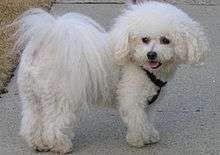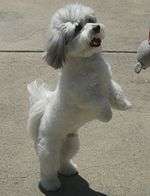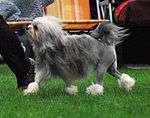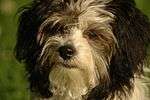Bichon
Bichon is the name for a type of related dog breeds in the non-sporting category. They vary in appearance, but all have tails curled over their back, hair that does not readily shed, a short snout, drop ears, and large, dark eyes. They were all bred to be amiable companion dogs and have a friendly, alert temperament. Their life expectancy is 15 years or more. The Bichon Frise, a type of bichon, is sometimes simply called a Bichon.
Etymology and history
The word bichon comes from Middle French bichon ('small long-haired dog'), a diminutive of Old French biche ('bitch, female dog'), from Old English bicce ('bitch, female dog'), related to Old Norse bikkja ('female dog') and German Betze ('female dog').[1][2] Some speculate that result of the apheresis, or loss of syllable, of the word barbichon ("small poodle"), a derivative of barbiche ("shaggy dog"); however, this theory seems chronologically unlikely (if not impossible) despite the apparent similarity of the two words. The French word bichon is attested from 1588, but barbichon does not appear until 1694.[3][4]
Bichons descended from the ancient ancestors of the Poodle and the Barbet. From these dogs came the barbichon, a small curly-coated Maltese; and the Bichon Bolognese, or simply Bolognese. There is argument about whether the Tenerife is the original stock for all bichons, or whether the Maltese (which seems to be an old type found on the islands before even the Barbet was known) is the progenitor of the bichons, through its breeding with Barbets. Ultimately, most of the modern bichon breeds have developed through the introduction of a variety of dogs to the barbichon type, establishing a family with recognizable characteristics in both temperament and type but without a single distinct progenitor.
Bichons were preferred court dogs of medieval Europe, especially finding favor in France, Italy, and Spain. The French word bichonner, which means 'to pamper' or 'doll up', derives from the beribboned and lavish lifestyle enjoyed by the bichon of Henry III of France (reigned 1574–1589), which was carried in a little basket wherever the King went.
Breeds
Maltese
The Maltese is undoubtedly ancient, and dogs of its type, with long hair and dropped ears, were associated in ancient Greek and Roman times with one of the two islands with the Roman name Melita (Malta or Mljet). In earlier imagery of the breed, it is shown with wavy fur, more typical of the bichons, and it is only relatively recently that a totally smooth-coated Maltese has developed as the final type. The Romans selected for a pure white coat from the very early varicolored Maltese-like dogs. The Maltese has steadily retained its popularity throughout the centuries, unlike any other bichon, most of which became very rare at least once in their history as fashions changed.

Bichon Frise
The modern Bichon Frise was created by combining the Bichon Tenerife with the Poodles and Barbets of the day to produce a bichon with a coat that is tightly curled, rather than wavy — hence the full name, Bichon a poil Frisé. Only white, and white tinged with buff, are allowed in the show ring. The Bichon Frise is a very cheerful breed, with a happy, sometimes clownish disposition, accented by its tail curled up high on its rump. They were very much in vogue in 16th-century France; they displaced the Maltese in court as the favorite. Today the breed is popular in Great Britain, Italy, France, and North America.

Coton de Tulear
The Tenerife also traveled to Reunion Island to develop the now-extinct Coton de Reunion, which then traveled to nearby Madagascar and became the Coton de Tulear. It is one of the few modern breeds that developed through natural selection and therefore comes in a range of colors.

Bolognese
The Bolognese was already being developed as a toy dog as early as the 11th century in Bologna, Italy. A favorite gift between courts, the little dog traveled to places like Spain, Belgium, France, Russia (as a gift to Catherine the Great), Romania and Austria. They only come in pure white.

Havanese
The Bichon Havanais, or Havanese, seems to have been descended from a variety of small, bichon-type dogs that traveled with Spanish and Italian sailors to Cuba. They were possibly bred with a now extinct poodle type from South America to produce a wavy coat which was also silky, but it may be that they simply expressed a wavy coat trait through a random chance of genetics. In appearance, breeders prefer a "natural" look, allowing all possible colors and letting the hair grow long.

Löwchen
The origins of the Löwchen are uncertain. Though classically considered a Mediterranean bichon dog, research into the origins of the dog show it may not have passed through the Mediterranean at all to travel to its current originating countries of Germany and the Netherlands. It is possible that the breed had some bichon blood, or that it is simply a terrier type from Tibet with no connections at all to the bichons. However, it does have a typical friendly bichon temperament. It comes in all colors.

Bolonka
Specifically in Russia, other bichons were developed, the Bolonki. After the retreat of Napoleon's army, left-behind bichons, primarily the Bolognese and Bichon Frise, were bred into a unique breed called the Franzuskaya Bolonka. After World War II, the French Bolonka was then bred with Poodles and silky terriers such as the Yorkshire Terrier to produce a small dog with a multi-coloured, long, wavy coat, called the Russian Tsvetnaya Bolonka, or Russian Multi-colored Bichon. Until recently, these breeds were unknown outside of Germany and Russia.
Modern bichons
Despite their current popularity, almost all bichons, even the very popular Bichon Frise, went through a period of decline in the 1800s. Court dogs became less fashionable in Europe at the turn of the 20th century, leading to the loss of many bichon types. Breeds like the Havanese and Bolognese are recovering from this period, and even more common bichons like the Löwchen and Bichon Frise were almost extinct at the beginning of the 20th century.
Today, bichons have again gained in popularity. The qualities that made the bichon family of dogs popular at court also make them suitable as house pets. Bichons are bred to be small, charming companion dogs with even temperaments and playful attitudes. They are good with children, but do not like to be held. They also display great watchdog abilities. A playful temperament is judged to be particularly important to the Bichon Frise. Properly bred bichons should not be yappy, standoffish, nervous or aggressive.
The modern Bichon Frise came to North America in the 1950s, and was admitted into the American Kennel Club (AKC) in 1972. They are not shown in the Toy Group, but in the Non-Sporting Group.
Footnotes
- Auguste Scheler, Dictionnaire d'étymologie française d'après les résultats de la science moderne, "bichon".
- Donkin, Diez, An etymological dictionary of the Romance languages, "biche".
- Centre National de Ressources Textuelles et Lexicales, "bichon".
- "myEtymology.com: French etymology of barbiche". Retrieved 9 December 2015.

